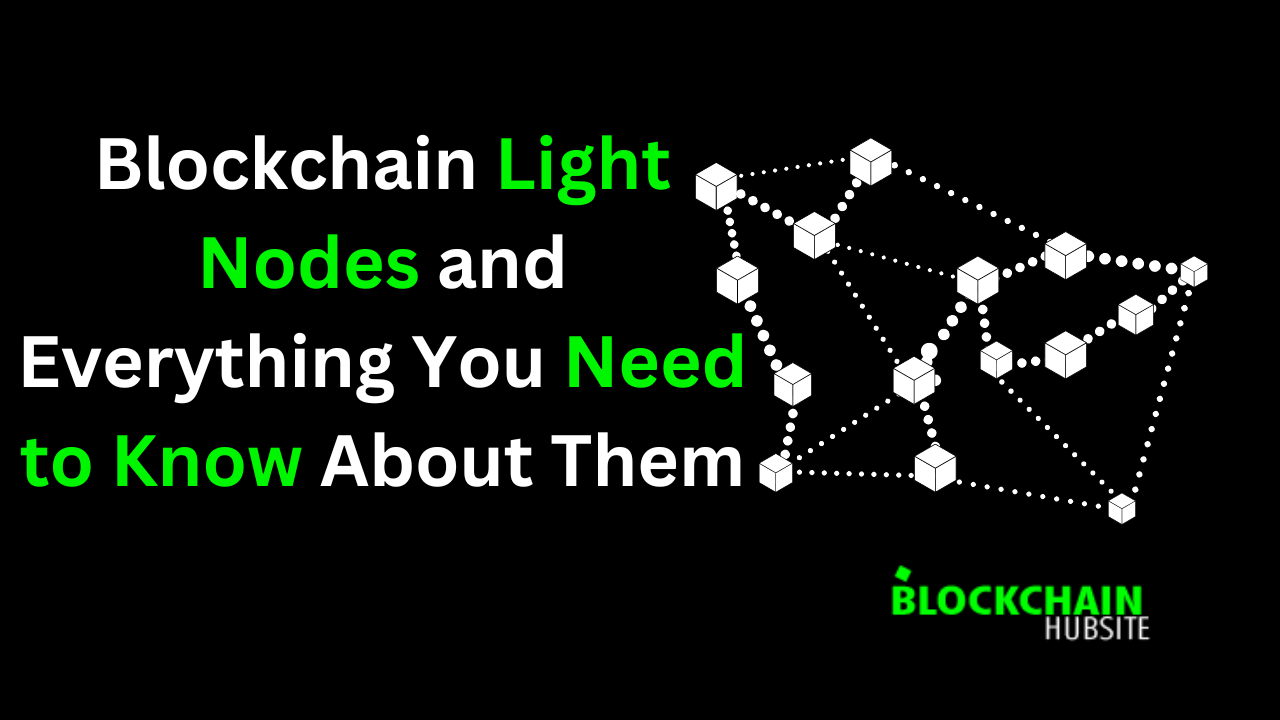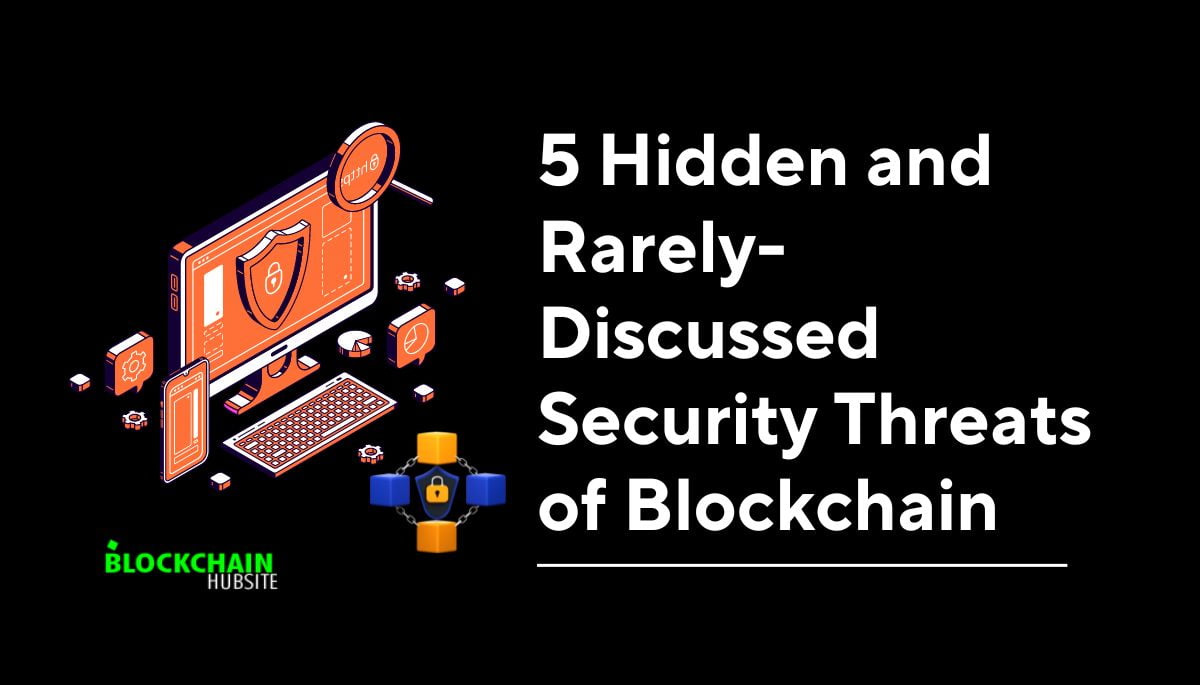
Table of Contents
Introduction
In recent years, blockchain technology has become very famous, and its decentralized and safe nature has revolutionized many industries. Full nodes are essential to the blockchain ecosystem as a whole because of the function they play in ensuring the security of the network and verifying transactions. However, running a full node can be time-consuming and costly on available resources due to the need to store the complete blockchain’s history.
To solve this problem, blockchain experts and developers proposed “light nodes” or “lightweight nodes.” These nodes provide an alternative for users and businesses who want to join blockchain networks but need access to or the budget for expensive computing or storage infrastructure.
In this article, we will learn more about blockchain light nodes, including what they are, how they work, and how they help the blockchain ecosystem.
What are Blockchain nodes?
Nodes are digital devices connected to the blockchain network, like computers, servers, phones, or wallets. Each device in the network connects to the blockchain so that everyone can benefit from the shared ledger and receive updates on the most recent transactions.
Since nodes verify entries in the distributed ledger, anyone with access to the network can verify the authenticity of transactions. The nodes’ primary responsibility is maintaining the network’s data’s integrity, confidentiality, and availability for all authorized users.
How nodes work?

Blockchains are decentralized ledgers that record every transaction made on a particular network. A blockchain is a continuously growing list (chain) of verified, approved transactions.
If you’re wondering where the blockchain is, it’s in the nodes. Every node maintains a duplicate copy of the transactions.
Each node in the blockchain receives a copy of the most recent block of transactions and broadcasts this information to the others so that they can all make identical changes to their respective databases.
You may have heard that a blockchain is “distributed” and “peer-to-peer.” This is possible because each node in the network acts as a check on the transactions of the others and maintains its copy of the distributed ledger.
What are the different Types of Nodes in Blockchain?
Nodes come in various forms, each with its unique set of capabilities. Nodes can refer to everything in a blockchain network, including users. However, not every device part of a blockchain network is a node, and not all have the same purpose.
There are different types of nodes in a blockchain network, each with its function and set of needs. For instance, specific nodes may be responsible for keeping track of transactions while others don’t.
A blockchain may have different nodes for users, clients, service providers, and others.
What is a Blockchain Light Node?
Blockchain Light Nodes, or SPV (Simplified Payment Verification) nodes, are a lighter version of Full Nodes. They are optimized for small, low-powered devices like smartphones and tablets. Light Nodes do not download the full blockchain but only the parts related to the transactions they will process.
Light Nodes must contact several Full Nodes in the network to validate their transactions and collect the necessary data. Light Nodes are more convenient and less resource-intensive than Full Nodes, but they are also less safe because they must rely on Full Nodes for validation.
This type of blockchain node is second only to archive nodes in terms of usage popularity, and it is optimized for the quick and easy processing of transactions and daily activities. Light nodes don’t download the entire blockchain. Hence they rely on Full Nodes for processing transactions.
What are the functions of a lightweight node?
Let’s examine the whole procedure to learn how a lightweight node works. A miner’s attempt to add a block of transactions to the blockchain triggers a background broadcast to all nodes in the network.
Nodes validate signatures and transactions based on whether or not they agree with the contents of a given block. In short, a node repeats the following actions:
- A node in a blockchain network verifies the validity of a transaction block.
- A node in a blockchain network is responsible for the saving and storage of transact
- ion blocks.
- Finally, it sends a signal containing the transaction record, allowing other nodes to synchronize with the blockchain.
How do blockchain lightweight nodes work?
Today’s cryptocurrencies, including Bitcoin, Dogecoin, Litecoin, and Ethereum, employ a Proof of Work (PoW) consensus method. PoW’s primary purpose is to avoid manipulation.
It uses a PoW algorithm but is moving toward a PoS algorithm, a more effective way to stop double-spending. Peer-to-peer networks rely on a consensus mechanism to efficiently transmit, receive, and process information in blockchain blocks and confirm transactions.
Choosing Between Full Nodes and Light Nodes
There are benefits and drawbacks to both full and light nodes, so deciding between the two will rely on your circumstances.
Full nodes need a lot of memory, CPU power, and network throughput to store the entire blockchain history. This might be time-consuming and costly for those with fewer resources or slower connections to the internet. While partial nodes rely on third-party services for transaction validation, full nodes do so autonomously, increasing privacy and security.
On the other hand, blockchain light nodes are more user-friendly and accessible because they only need to download a subset of the blockchain data from full nodes or servers. Since this significantly lowers the network requirements, it opens Bitcoin to more mobile and desktop users. Light nodes, on the other hand, give up some anonymity and security in exchange for the convenience of having other nodes validate their transactions.
Therefore, consider your technological expertise, available resources, privacy preferences, and risk tolerance while deciding between full and light nodes.
Types of Blockchain Light Nodes

Light nodes can be classified into different categories based on the information they verify:
- Consensus verifiers
- State verifiers
- Data availability (DA) verifiers
- Full verifiers
Consensus verifiers
Consensus verifiers can check if a transaction is part of the canonical chain. They follow the canonical chain by keeping track of validator attestations and checking transactions by checking Merkle proofs.
This is analogous to how IBC operates. Cosmos chains run agreement verifiers on each chain and check the consensus of connected chains. In general, light nodes are agreement verifiers today.
Ethereum light nodes need to be more verifiers of agreement. But the problem is being solved differently, and within a year, Ethereum should have consensus verifiers that work.
Even though consensus verifiers are helpful, there is still some risk. You are still relying on the validators. What happens if the validators include an incorrect transaction or state transition?
State verifiers
This is where state verifiers come into play. State verifiers can validate state transitions independently of transaction execution.
This can be done with the help of either validity (also known as ZK) proofs or forgery proofs. Light nodes check the proofs they get with the block headers to see if the new state is correct (for validity proofs) or wrong (for scam proofs).
In contrast to blockchain light nodes, which rely on full nodes to inform them of fraud and prevent them from accepting new states, validators can directly convince light nodes that blocks are genuine and cause them to accept new states by presenting them with validity proofs.
More work is needed, although state verifiers are robust (and mobile-friendly!).
Even if nodes know that the computations were performed correctly, they may not be able to retrieve information about the latest state of the blockchain from full nodes if validators choose not to publish it. There are more sophisticated data hacks, but this one demonstrates why the blockchain cannot advance.
DA verifiers
The last piece of the puzzle is DA verifiers. Without downloading the data, they can verify that the computation’s inputs are available from a location the network can access.
How is that possible? Using a method known as “data availability sampling.” You can be sure that all the block data is available somewhere if many light nodes are checking small pieces of it. More sample nodes mean more safety.
Full Verifiers
Technically speaking, full verifiers are not light nodes; however, they do represent the other end of the spectrum. A fully-validated node known as a full verifier retains the entire blockchain history, authenticates all transactions and blocks, takes part in consensus, and maintains the network’s present state.
In the blockchain network, full verifiers provide the maximum level of security and trustlessness. However, because they demand a lot of resources, they are typically operated by miners, network validators, or businesses that have the necessary infrastructure to manage the entire blockchain.
How to Set Up a Light Node
To set up a light node, you’ll need to do the following:
Choose a network on the blockchain: First, you’ll need to choose a blockchain network for your light node to join. Some of the most popular picks are Ethereum, Bitcoin, and Litecoin.
Install the necessary software: You should download and run the software for your chosen blockchain network. For example, you can use tools like Geth or Parity to set up a light node for Ethereum.
Configure the light node: After installing the software, you must configure the light node. Usually, this means choosing the network you want to connect to, setting up the parameters for synchronization, and choosing the data you wish your light node to keep.
Please connect to the network: Run the software on the light server and connect it to your desired network. Depending on the software, you may need to give more details, such as network endpoints or peers to connect to.
Sync the blockchain: The small node will start to sync with the blockchain network. Since light nodes don’t receive the whole blockchain, they use other full nodes or infrastructure to get the information they need when they need it. The synchronization process may take a while, depending on the network and how much data is synced.
Interact with the blockchain: Once your light node is fully synchronized, you can interact with the blockchain network. You can make transactions, get data, or do other things on the blockchain by using APIs, libraries, or other tools that the software gives you.
Maintain and update: It’s essential to keep your light node software up to date with the latest versions to ensure compatibility, security, and access to new features. Maintain a regular upgrading schedule and ensure you’re checking for updates.
Benefits of Using a Lightweight Node
Lightweight nodes are beneficial because they are simple to use and can be accessible with only a few clicks on a smartphone, computer, or other device. Lightweight nodes can be accessible anytime, anywhere, via an internet connection and a mobile device (phone or tablet). This kind of wallet lets you access your crypto assets at any time, from anywhere.
Blockchain light node and cryptocurrency wallets
In the world of cryptocurrencies, wallets are a hot topic. It’s the place where you keep your money, and it should be a secure place. There are a wide variety of wallet options available, including digital, paper, and hardware wallets. You also have the option of keeping your funds on a private node. You will receive a wallet, whether you run a full node or a light client, which will be accessible only to you. This could be the best choice, but it requires some work.
First, let’s talk about a “full node.” It’s also called a “BTC node.” With a full node, you help the blockchain network by giving the network access to your computer’s power. To start running your own node, you have to download a full copy of the bitcoin blockchain. Other than that, you have to meet certain requirements to be able to run a full node. The current requirements to run a full Bitcoin node are:
- At least 300GB of disk space. Each node needs to download the whole Bitcoin Blockchain, which is about 248GB right now but is growing quickly.
- 4 GB of RAM (More RAM is preferable)
- 5GB of upload bandwidth and 500MB of download bandwidth per day, plus a stable link
- The node’s ability to run for at least 6 hours per day (again, the more, the better).
If you meet these conditions and learn how to run your own node, you will be able to host your own wallet. You have full control over every single transaction that comes in and goes out. You are always in charge of everything you do. This means that when you use your own node to make a transaction, your transaction will be further down the line than other people’s transactions. This implies that you are in complete control of your actions and that you can support any blockchain you choose.
What does “light client” mean?
A light client is a program that lets you use all of the features of the blockchain network without having to run a full copy of the blockchain. Running a node can be expensive, and some people may not be able to do it. However, there is another option: a small client.
A lite client connects to the blockchain network by connecting to the internet and communicating with other nodes. This means that it doesn’t need a lot of computer power or disk space. Furthermore, it uses a small amount of bandwidth. All you need to get started with your light wallet is a working internet link.
Which Public Blockchain offers the Lightest Full Node Client?
Lightweight blockchain clients come in a wide variety of forms. However, some of the more popular ones are:
Solana: Solana is a blockchain project that seeks to deliver high scalability and throughput using a lightweight client. The Solana team claims that by 2021, their Rust-based client will require less than 300 MB of RAM.
Algorand: The Algorand blockchain also emphasizes that running a server requires the fewest resources possible. According to reports, their main Go-based client is under 600MB as of 2022.
NEAR Protocol: NEAR says that their Rust-based client can sync and confirm the chain in under 30 minutes on a 4-core machine using less than 1GB of RAM.
IoTeX : The IoTeX Network reports that its Golang client requires about 200MB of memory. Their goal is to assist low-power Internet of Things devices.
Nano: Nano is a low-latency, lightweight network protocol. The compiled size of their node software is less than 30MB, and the ledger may be stored in just a few gigabytes.
What are the potential risks (disadvantages) of running a lightweight node?
If you plan on deploying a lightweight node into the network, you should be aware of the dangers it poses. However, restricting a node wallet’s connections to your full node can significantly reduce its dangers.
Validation
The main issue with lightweight wallets is that they must verify compliance with Bitcoin’s regulations. For instance, if someone pays a user of a lightweight wallet with fake bitcoins, the wallet will accept them, and the user will be responsible for paying the associated fees.
Security
Lightweight nodes provide a severe security risk because they bypass essential security measures. For instance, on July 4, 2015, all lightweight nodes were vulnerable due to an unexpected chain fork, whereas fully updated full node wallets were unaffected.
Privacy
Lightweight wallets’ path is exchanging e-mail addresses with a reliable third party in exchange for access to one’s wallet’s balance and transaction history. The neutral third party can then track the user’s past and future financial activity. Full-node wallets, however, download the complete blockchain and scan it locally, preventing this massive data leak.
Frequently Asked Questions(FAQs)
1. What are the functionalities performed by light nodes in Bitcoin?
Users may access the blockchain’s data without having to store the entire blockchain thanks to Bitcoin’s light nodes, which perform light-weight verification of transactions and blocks.
2. How do light nodes work?
Light nodes rely on Simplified Payment Verification (SPV) to verify payments by requesting essential data from full nodes or other light nodes in the network.
3. Do crypto nodes make money?
Nodes typically don’t generate income in a direct manner. They help the network by approving transactions and preserving its integrity, but they do not get paid directly for their services.
4. How do nodes get paid?
Nodes don’t get paid directly, including Bitcoin nodes. Miners are rewarded with newly generated currencies and transaction fees for creating new blocks.
5. How do I run a Bitcoin light node?
You can interact with the blockchain without downloading all of the data by using SPV wallet software like Electrum or a mobile wallet like Breadwallet to operate a Bitcoin light node.
6. What is the difference between a light and a full blockchain client?
A light blockchain client (SPV wallet) merely downloads and verifies a small fraction of the blockchain data, relying on others for validation. A full blockchain client, which offers higher security but uses more storage and bandwidth, downloads and verifies the entire blockchain.
7. How many nodes are in the Bitcoin Lightning Network?
The Lightning Network is expanding quickly; as of this writing, there are 31,965 public Lightning Nodes, an increase of 5% over the previous 30 days. It is challenging to determine the precise number of lightning nodes in existence. This is because certain nodes only open private channels.
8. What is the difference between nodes and miners?
Nodes are in charge of verifying and relaying transactions, preserving the integrity of the blockchain. On the other hand, miners build new blocks, secure the network, and receive new coins and transaction fees in exchange.
9. Is buying nodes a good investment?
Purchasing nodes is not a direct investment in the traditional sense. It is more of an improvement to the security and decentralization of the network. Supporting a decentralized system rather than gaining money is the potential reward.
10. How do you get passive income from crypto?
Staking, yield farming, lending, managing a masternode, and taking part in liquidity pools are some of the ways that cryptocurrency investors might generate passive income. Different methods have varying degrees of risk and profit.
11. How do you become a Lightning node?
You must install, operate, and link a Lightning Network node implementation, such as LND or c-lightning, to the Lightning Network in order to support off-chain transactions.
12. What is the world’s lightest blockchain?
Mina claims to be the world’s lightest blockchain since it intends to maintain its size independent of usage growth. It intends to address the blockchain size issues that have plagued prior projects during development by making the whole blockchain smaller than the majority of images on your phone.




